Snakes of the Townsville region
There can be great variation between individuals within a single species of snake. The descriptions below are based on general characters. It can be difficult to positively identify some snakes. Never approach snakes and never assume that they are non-venomous.
Front-fanged venomous snakes (family Elapidae)
This family includes front-fanged, venomous land snakes. Although this encompasses the highly venomous snakes of Australia, the venom of most species is harmless to humans. The venom injected by these snakes is used to immobilise or kill prey - sometimes a combination of toxic venom and constriction is used. These snakes are known to feed on small mammals, birds, reptiles (including other snakes) and amphibians.
Coastal taipan Oxyuranus scutellatus
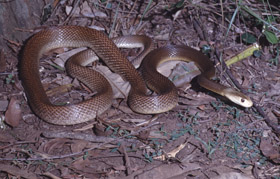
Coastal taipan
Photo credit: Queensland Government
Warning: Highly venomous
The coastal taipan is light to pale brown above and paler on the sides. The snout and lower jaw is paler than the rest of the body, usually pale-yellow in colour. The head is rectangular ('coffin-shaped') with a distinct neck. They have large eyes with a reddish-copper iris and round pupils. Taipans are mostly active during the day, feeding on small mammals in eucalypt woodland, grassland, grassy beach dunes, pastures and cane fields. Taipans will defend themselves aggressively if provoked. They grow to an average length of 2.6m.
Common death adder Acanthophis antarcticus and northern death adder Acanthophis praelongus
 Open larger image
Open larger image
Common death adder
Photo credit: Queensland Museum
 Open larger image
Open larger image
Northern death adder
Photo credit: Queensland Museum
Warning: Highly venomous
The death adder is variable in colour, usually with contrasting cross-bands and has a large, almost triangular head and stout body. The thin rat-like tail ends in a curved soft spine and the tip is cream or black. Its shape and colouration mean that it could initially be mistaken for a blue-tongued lizard or one of the larger ground-dwelling skinks (and vice-versa). During the day they can be found buried in sand, soil or leaves, often at the base of a tree. When disturbed, they remain where they are and rely on their camouflage for protection, resorting to a lightning fast strike when the threat becomes too great. It feeds on reptiles, mammals and birds, and attracts prey by using the tail as a lure. The average size of a death adder is 0.4m with a maximum length of 1m.
Eastern brown snake Pseudonaja textilis
 Open larger image
Open larger image
Eastern brown snake
Photo credit: © Steve K. Wilson
 Open larger image
Open larger image
Eastern brown snake
Photo credit: © Steve K. Wilson
Warning: Highly venomous
The eastern brown snake varies widely in colour from light tan to almost black. The belly ranges from cream to orange with darker orange blotches. To add confusion, hatchlings may have a darker head and neck band or can have dark cross-bands along their entire length. These patterns gradually disappear with age. The eastern brown snake occurs in a variety of habitats ranging from grassland through to eucalypt forests. It is distributed throughout all but the western parts of Queensland. Active during the day, the eastern brown snake feeds on frogs, birds, mammals and reptiles. If provoked, the snake will rear up and adopt an S-shape strike posture, and will bite if cornered or provoked. The eastern brown snake grows to an average length of 1.5m.
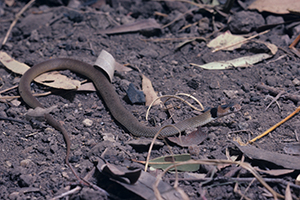
Eastern brown snake
Photo credit: Queensland Government
 Open larger image
Open larger image
Different colour patterns of juvenile eastern brown snakes.
Photo credit: Tom Mumbray
Western brown snake Pseudonaja nuchalis
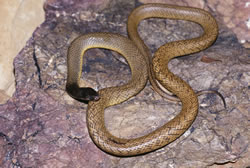
Western brown snake
Photo credit: Queensland Government
Warning: Highly venomous
The western brown snake, also known as the Gwardar, is a highly variable species ranging from light brown to almost black in colour above, but typically having orange spots on the belly. They are active primarily during the day, but may forage at night during the summer months. This species occurs in a variety of habitats ranging from dry forests and woodland to central deserts. Their diet consists mainly of small mammals and reptiles. Western brown snakes grow up to 1.5 m in length.
Red-bellied black snake Pseudechis porphyriacus
 Open larger image
Open larger image
Red-bellied black snake
Photo credit: Queensland Museum
Warning: Venomous
The red-bellied black snake is shiny black above with a red belly (sometimes pinkish or white). These snakes occur in a variety of habitats near water but are more frequently encountered in wetter vegetation communities. They are active during the day and are often found basking in sunny patches in grass. Red-bellied blacks feed primarily on frogs but also eat small mammals and reptiles. They bear live young and can grow to an average length of 2m.
Myall snake Suta suta
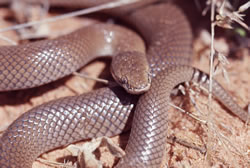
Suta suta snake also known as Myall snake
Photo credit: Queensland Museum
Warning: Venomous/bite can be painful
The myall snake (or curl snake) is pale fawn to reddish brown in colour with a darker brown or blackish hood on the head. A lighter brown stripe runs from the nostril over the eye. It is venomous but not regarded as dangerous although the bite can be extremely painful. Myall snakes can be found under fallen trees or rocks during the day. At night they feed on small lizards and mammals. They give birth to live young. Myall snakes grow to an average length of 40 cm (reaching a maximum length of 60 cm).
Black whip snake Demansia vestigiata
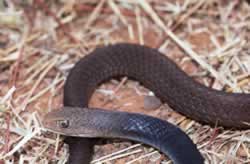
Black whip snake
Photo credit: Queensland Government
Warning: Venomous/large individuals should be treated with caution
The black whip snake is grey or dark brown to black with each body scale marked with black. The belly is greyish, with the underparts of the tail reddish. When disturbed, the black whip snake expands its body revealing a distinct pattern of black spots and white dashes. It occurs in a range of habitats from open woodlands to dry forests and is active during the day feeding on small animals such as lizards. It grows to an average length of 1m.
Collared whip snake Demansia torquata

Collared whip snake
Photo credit: Queensland Government
Warning: Venomous
The collared whip snake is very slender, grey to brown in colour above with the head darker than the body. The head is marked with a narrow dark line across the front of the snout and between the nostrils. A pale rim exists around the eye and a dark streak curves back beneath it to form a distinct 'comma' shape. This snake lives in open forest (common on Castle Hill) and uses weak venom to capture skinks and geckos. Collared whip snakes grow up to 70cm in length.
Yellow-faced whip snake Demansia psammophis
 Open larger image
Open larger image
Yellow-faced whip snake
Photo credit: Queensland Museum
Warning: Venomous/large individuals should be treated with caution
The yellow-faced whip snake has a dark yellow-edged bar around the front of the nose and a dark comma-shaped streak from the eye to the mouth. Whip snakes are slender with whip-like tails. They are active during the day, very agile and usually escape quickly when disturbed. It can grow to an average length of 80cm.
Coral snake Simoselaps australis
 Open larger image
Open larger image
Coral snake
Photo credit: Queensland Museum
Harmless
The coral snake is dull to bright pink or red in colour above, banded with numerous narrow cross-bands with cream or yellow centres and dark brown edges. A black bar with creamy yellow edging crosses the head and encloses the eyes. Another broad bar with pale edges crosses the nape. This nocturnal, burrowing snake feeds on lizards and is harmless to humans. Coral snakes grow to an average length of 50cm.
Non-venomous and rear-fanged venomous snakes (family Colubridae)
This family includes a small group of snakes with a range of specialised characteristics and habits. Some of these species are arboreal while others favour semi-aquatic habitats. These snakes are either solid-toothed and non-venomous or rear-fanged and weakly venomous. They eat small prey including frogs, lizards, birds and rodents.
Common or green tree snake Dendrelaphis punctulata
 Open larger image
Open larger image
Common or green tree snake
Photo credit: © Queensland Museum
Non-venomous
The common tree snake is highly variable in colour and is also known as green tree snake, yellow-bellied or blue-bellied black snake. The body is extremely slender and can be either grey, olive-green, various shades of brown, black, even blue and turquoise. When disturbed it can inflate its body to show patches of bright blue skin between the body scales. The underside is usually cream or yellow or light blue in some individuals. Common tree snakes are found in a variety of habitat types, but are usually seen in eucalypt woodland or rainforest areas. They are active during the day in trees and on the ground, feeding mostly on frogs and birds. They grow to an average length of 1.5m.
Brown tree snake Boiga irregularis
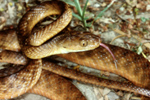
Brown tree snake
Photo credit: Queensland Government
Warning: Venomous (rear-fanged). Bites from large individuals should be monitored carefully.
The brown tree snake is sometimes known as the 'doll's eye' or 'night tiger', names referring to its doll-like yellow eyes and banded body. It is usually brown to reddish-brown with irregular darker cross-bands. The brown tree snake is mainly found in eucalypt woodland but also occurs in rainforest. It is nocturnal and is generally found in trees. The snake eats mainly birds and their eggs, but will also prey upon small mammals, frogs and reptiles. The species is rear-fanged with weak venom. It can grow up to 2m long.
Keelback Tropidonophis mairii (also known as freshwater snake)
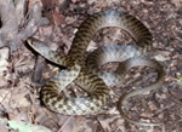
Keelback
Photo credit: Queensland Government
Non-venomous
The keelback or freshwater snake’s head and neck are grey-green or brown with the body grey-green to brown typically with cross-bands of darker flecks. Upper body scales are strongly keeled or ridged. A loreal scale is present (a scale situated between the nasal scale and scales directly in front of eye), distinguishing it from the venomous rough-scaled snake. The keelback is found in and around creeks, rivers and marshlands. It feeds largely on frogs (including cane toads) that it actively pursues during the day or night. It grows to an average length of 0.5m. Caution: this snake closely resembles the venomous and dangerous rough-scaled snake.
Slaty-grey snake Stegonotus cucullatus
 Open larger image
Open larger image
Slaty-grey snake
Photo credit: Queensland Museum
Non-venomous
The slaty-grey snake is uniform brown to leaden-grey or black above with a white or cream belly. It is a nocturnal snake that lives around human habitations and usually forages on the ground for frogs. When disturbed it releases a strong odour from its anal gland. The slaty-grey snake grows up to 1.3m.
Pythons: non-venomous constrictors (family Boidae)
Most pythons are large snakes well equipped for detecting, immobilising and consuming large prey. Pythons are generally nocturnal, but are known to bask in the sun during the cooler months. They are non-venomous, with backward curving solid-teeth (no fangs). Pythons kill by coiling around their prey and squeezing until suffocation occurs - a technique known as constriction. Pythons feed largely on mammals, reptiles and birds. Most have heat-sensing pits along the lower jaw to locate warm-blooded prey. These pits can detect temperature changes of less than one-thirtieth of a degree.
Amethystine python Morelia kinghorni
 Open larger image
Open larger image
Amethystine python
Photo credit: Queensland Government
Non-venomous
This is Australia's largest snake. It is iridescent greenish, grey or brown, usually with dark lines and streaks above often giving off an amethyst sheen. It has large scales arranged symmetrically on the top of the head. This snake lives in rainforest, coastal scrub and open forest from Townsville to Cape York. It feeds mainly on mammals and birds and is capable of taking animals as large as a wallaby. The average length of this species is 5m but one has been recorded at 8.5m.
Black-headed python Aspidites melanocephalus

Black-headed python
Photo credit: Queensland Government
Non-venomous
The black-headed python is dark brown above, often lighter on the sides with numerous brown or blackish cross-bands. Its head, neck and throat are black. It is generally found inland. It is mostly active at night but can be diurnal during the cooler months. It feeds largely on reptiles, including venomous snakes although small mammals and birds are occasionally taken. This species does not have the heat-sensing pits on the lower jaw that are found in other pythons. It grows to an average length of 1.5m (reaching a maximum length of 2.5m).
Carpet python Morelia spilota
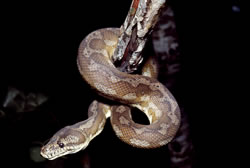
Carpet python
Photo credit: Queensland Government
Non-venomous
The carpet python has many colour variations ranging from pale to darker greyish-green or brown. It has black-edged pale blotches enclosing pale yellow spots and markings. The belly is cream or yellow, variegated with dark grey scales. The scales on top of the head are granular (there are no large head shields between the eyes). It is often found in trees, sometimes living in another animals' burrow. These pythons are often encountered on the road on warm spring and summer nights in all habitat types within their range. They are mainly active at night, feeding on mammals, reptiles, birds and frogs. They grow to an average length of 2m (specimens are known to exceed 4m).
Spotted python Antaresia maculosa
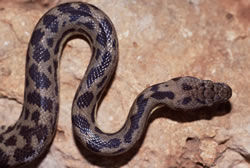
Spotted python
Photo credit: Queensland Government
Non-venomous
The spotted python is generally light brown in colour with a series of darker brown blotches along the back giving the impression of irregular spots. It is found in a variety of habitats ranging from eucalypt woodland through to rainforest and is usually seen at night. It feeds on reptiles, birds and small mammals. The spotted python grows to an average length of 0.75m.
Water python Liasis fuscus

Water python
Photo credit: Lyall Naylor
Non-venomous
The water python is uniform iridescent dark brown to black in colour above, usually with a bright- to dull-yellow belly. Water pythons, like most other python species in Queensland, use heat-sensing pits situated on the lower jaw to locate their prey. It is mainly active at night in the vicinity of water in eucalypt woodland. Water pythons feed mainly on birds, predominately waterfowl, and small mammals. The water python grows to and average length of 2m, reaching a maximum length of 3m.
File snakes: (family Acrochordidae)
Little file snake Acrochordus granulatus
Non-venomous
The little file snake is an aquatic marine and estuarine snake. They are grey, brown or almost black in colour with narrow whitish to fawn-coloured cross-bands that fade on the belly. The skin is loose and covered in fine, pointed scales giving it the appearance and texture of a file. It feeds mainly on small crabs and fish. Little file snakes grow to an average length of 60cm (although specimens are known to 1.2m).
Blind snakes (family Typhlopidae)
Ramphotyphlops spp.
 Open larger image
Open larger image
Blind snake
Photo credit: Queensland Museum
Non-venomous
Blind snakes are small, smooth, worm-like burrower with glossy, close fitting scales and their tails are bluntly rounded, ending in a short spur. They have small, dark spots for eyes which probably only sense light and dark. These snakes feed on termites and the eggs, larvae and pupae of ants and are often encountered foraging on the surface at night following rain. Blind snakes are non-venomous and the structure of their mouths makes them incapable of biting humans. However they do have well developed anal glands that secrete a strong smell when disturbed.
Legless lizards (family Pygopodidae)
Legless lizard
 Open larger image
Open larger image
Legless lizard
Photo credit: Queensland Museum
Some backyard reptile encounters may involve a small snake-like creature that could be a legless lizard. Unlike snakes, legless lizards have external ear openings, broad fleshy tongues and belly scales that are the same size as those on their upper body. Remnants of hind limbs (flaps) can be seen. Legless lizards are non-venomous burrowers that live in moist, dark areas. They feed on insects and small reptiles, and are usually found in or near compost bins and vegetable gardens or under leaf litter.
Some skinks (family Scincidae) that live in leaf litter or burrow in the ground also have reduced or absent limbs. These skinks share many of the characteristics of legless lizards.